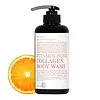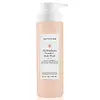What's inside
What's inside
 Key Ingredients
Key Ingredients

 Benefits
Benefits

 Concerns
Concerns

 Ingredients Side-by-side
Ingredients Side-by-side

Water
Skin ConditioningSodium Laureth Sulfate
CleansingGlycerin
HumectantPropylene Glycol
HumectantCocamide Mea
EmulsifyingLauramide DEA
Polyquaternium-10
Cocamidopropyl Betaine
CleansingSodium Chloride
MaskingSodium Benzoate
MaskingChlorphenesin
AntimicrobialButylene Glycol
Humectant1,2-Hexanediol
Skin ConditioningPinus Palustris Leaf Extract
TonicUlmus Davidiana Root Extract
Skin ConditioningOenothera Biennis Flower Extract
AstringentPueraria Lobata Root Extract
HumectantGlycine Max Seed Extract
Skin ConditioningSesamum Indicum Seed Extract
Skin ConditioningOryza Sativa Extract
AbsorbentCitric Acid
BufferingSodium Hyaluronate
HumectantHamamelis Virginiana Leaf Extract
Skin ConditioningNelumbium Speciosum Flower Extract
Skin ConditioningSolanum Melongena Fruit Extract
Skin ConditioningMelaleuca Alternifolia Leaf Extract
PerfumingHydrolyzed Collagen Extract
Skin ProtectingDipropylene Glycol
HumectantHippophae Rhamnoides Fruit Extract
Skin ConditioningAscorbic Acid
AntioxidantSqualane
EmollientBeta-Glucan
Skin ConditioningDisodium EDTA
Parfum
MaskingCitral
PerfumingGeraniol
PerfumingLimonene
PerfumingLinalool
PerfumingWater, Sodium Laureth Sulfate, Glycerin, Propylene Glycol, Cocamide Mea, Lauramide DEA, Polyquaternium-10, Cocamidopropyl Betaine, Sodium Chloride, Sodium Benzoate, Chlorphenesin, Butylene Glycol, 1,2-Hexanediol, Pinus Palustris Leaf Extract, Ulmus Davidiana Root Extract, Oenothera Biennis Flower Extract, Pueraria Lobata Root Extract, Glycine Max Seed Extract, Sesamum Indicum Seed Extract, Oryza Sativa Extract, Citric Acid, Sodium Hyaluronate, Hamamelis Virginiana Leaf Extract, Nelumbium Speciosum Flower Extract, Solanum Melongena Fruit Extract, Melaleuca Alternifolia Leaf Extract, Hydrolyzed Collagen Extract, Dipropylene Glycol, Hippophae Rhamnoides Fruit Extract, Ascorbic Acid, Squalane, Beta-Glucan, Disodium EDTA, Parfum, Citral, Geraniol, Limonene, Linalool
Water
Skin ConditioningSodium Cocoyl Isethionate
CleansingCocamidopropyl Hydroxysultaine
CleansingGlycerin
HumectantCoco-Glucoside
CleansingSodium Methyl Cocoyl Taurate
CleansingSodium Hyaluronate
HumectantAcrylates/C10-30 Alkyl Acrylate Crosspolymer
Emulsion StabilisingAscorbyl Glucoside
AntioxidantPapain
Skin ConditioningNiacinamide
SmoothingBromelain
Skin ConditioningSodium PCA
HumectantVaccinium Myrtillus Bud Extract
AntioxidantSaccharum Officinarum Extract
MoisturisingCitrus Limon Fruit Extract
MaskingAcer Saccharum Extract
Skin ConditioningCitrus Aurantium Dulcis Fruit Extract
MaskingGlycol Distearate
EmollientPolyquaternium-51
Skin ConditioningCaprylic/Capric Triglyceride
MaskingCitrus Aurantium Amara Leaf/Twig Extract
Skin ConditioningPhenoxyethanol
PreservativeCocamide Mipa
EmulsifyingTriethyl Citrate
MaskingSodium Hydroxide
BufferingEthylhexylglycerin
Skin ConditioningUrea
BufferingTetrasodium Glutamate Diacetate
Trehalose
HumectantMaltodextrin
AbsorbentWater, Sodium Cocoyl Isethionate, Cocamidopropyl Hydroxysultaine, Glycerin, Coco-Glucoside, Sodium Methyl Cocoyl Taurate, Sodium Hyaluronate, Acrylates/C10-30 Alkyl Acrylate Crosspolymer, Ascorbyl Glucoside, Papain, Niacinamide, Bromelain, Sodium PCA, Vaccinium Myrtillus Bud Extract, Saccharum Officinarum Extract, Citrus Limon Fruit Extract, Acer Saccharum Extract, Citrus Aurantium Dulcis Fruit Extract, Glycol Distearate, Polyquaternium-51, Caprylic/Capric Triglyceride, Citrus Aurantium Amara Leaf/Twig Extract, Phenoxyethanol, Cocamide Mipa, Triethyl Citrate, Sodium Hydroxide, Ethylhexylglycerin, Urea, Tetrasodium Glutamate Diacetate, Trehalose, Maltodextrin
 Reviews
Reviews

Ingredients Explained
These ingredients are found in both products.
Ingredients higher up in an ingredient list are typically present in a larger amount.
Glycerin is already naturally found in your skin. It helps moisturize and protect your skin.
A study from 2016 found glycerin to be more effective as a humectant than AHAs and hyaluronic acid.
As a humectant, it helps the skin stay hydrated by pulling moisture to your skin. The low molecular weight of glycerin allows it to pull moisture into the deeper layers of your skin.
Hydrated skin improves your skin barrier; Your skin barrier helps protect against irritants and bacteria.
Glycerin has also been found to have antimicrobial and antiviral properties. Due to these properties, glycerin is often used in wound and burn treatments.
In cosmetics, glycerin is usually derived from plants such as soybean or palm. However, it can also be sourced from animals, such as tallow or animal fat.
This ingredient is organic, colorless, odorless, and non-toxic.
Glycerin is the name for this ingredient in American English. British English uses Glycerol/Glycerine.
Learn more about GlycerinSodium Hyaluronate is hyaluronic acid's salt form. It is commonly derived from the sodium salt of hyaluronic acid.
Like hyaluronic acid, it is great at holding water and acts as a humectant. This makes it a great skin hydrating ingredient.
Sodium Hyaluronate is naturally occurring in our bodies and is mostly found in eye fluid and joints.
These are some other common types of Hyaluronic Acid:
Learn more about Sodium HyaluronateWater. It's the most common cosmetic ingredient of all. You'll usually see it at the top of ingredient lists, meaning that it makes up the largest part of the product.
So why is it so popular? Water most often acts as a solvent - this means that it helps dissolve other ingredients into the formulation.
You'll also recognize water as that liquid we all need to stay alive. If you see this, drink a glass of water. Stay hydrated!
Learn more about Water